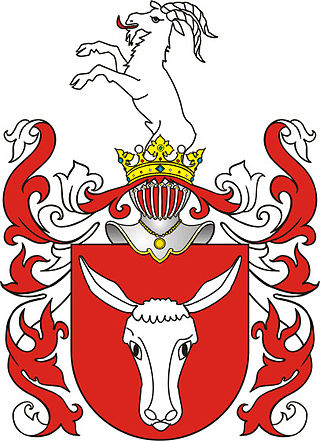
Grunwald is a part of the city of Poznań in western Poland. It was one of the five governmental districts (dzielnica) into which the city was divided prior to 1990, and which are retained for certain administrative purposes.

Walter Morten Grunwald was a Danish actor, stage director and theatre manager.

Półkozic is a Polish coat of arms. It was used by several szlachta families in the times of the Polish–Lithuanian Commonwealth.

Henry Anatole Grunwald was an Austrian-born American journalist and diplomat. He was best known for his position as managing editor of Time magazine and editor in chief of Time, Inc.

Glen Grunwald is an attorney and basketball executive who serves as the Executive Advisor of Canada Basketball and as a Senior Advisor of the Memphis Grizzlies.

Grünwald is a municipality in the district of Munich, in the state of Bavaria, Germany. It is located on the right bank of the Isar, 12 km southwest of Munich (centre). As of 31 December 2020 it had a population of 11,303.
Anatole "Tolly" de Grunwald was a Russian British film producer and screenwriter.

Ash Grunwald is an Australian blues musician. He has released nine studio albums and has received five nominations for ARIA Music Awards. Five albums have charted in the ARIA Albums Chart top 50; Fish out of Water (2008), Hot Mama Vibes (2010), Trouble's Door (2012), Gargantua (2013) and Mojo (2019).

The Grunwald Swords are a pair of simple bare swords sent as a mocking "gift" by Ulrich von Jungingen, the Grand Master of the Order of Teutonic Knights, to King Władysław II Jagiełło of Poland and Grand Duke Vytautas of Lithuania. The swords were sent on 15 July 1410, just before the Battle of Grunwald (Tannenberg), as a symbolic invitation to engage Jungingen's forces in battle. After the Polish–Lithuanian victory, both swords were taken as a war trophy by King Władysław II to Kraków, Poland's capital at the time, and placed in the treasury of the Royal Wawel Castle.

The Battle of Grunwald, Battle of Žalgiris, or First Battle of Tannenberg, was fought on 15 July 1410 during the Polish–Lithuanian–Teutonic War. The alliance of the Crown of the Kingdom of Poland and the Grand Duchy of Lithuania, led respectively by King Władysław II Jagiełło (Jogaila), and Grand Duke Vytautas, decisively defeated the German Teutonic Order, led by Grand Master Ulrich von Jungingen. Most of the Teutonic Order's leadership were killed or taken prisoner.

Geophis sanniolus, commonly known as the pygmy snail-eating snake or the pygmy snail sucker, is a species of small snake in the family Colubridae. The species is endemic to Central America and southeastern Mexico.

Geophis is a genus of snakes in the subfamily Dipsadinae of the family Colubridae of the superfamily Colubroidea. Species in the genus Geophis are commonly referred to as Latin American earth snakes. The genus consists of 53 distinct species.
Geophis immaculatus, Downs's earth snake, is a small snake of the colubrid family. It is native to Mexico and Guatemala. There are no recognized subspecies. Although not much has been documented about it, the population distribution is in abundance and is of least concern in terms of conservation status.

Geophis dunni, Dunn's earth snake, is a species of enigmatic snake in the family Colubridae. The species is presumably endemic to Nicaragua and is only known from a single specimen discovered in 1932. This specimen, the holotype, was discovered by Karl Patterson Schmidt in the stomach of a Central American coral snake, and no additional specimen has been seen since. The holotype has a snout-to-vent length (SVL) of 310 mm (12 in), a tail length of 57 mm (2.2 in), and a total length of 367 mm (14.4 in). It is part of the Geophis sieboldi species group according to Floyd Leslie Downs. This species was named by Schmidt after fellow herpetologist Emmett Reid Dunn "in allusion to his important contributions to our knowledge of this group of snakes".
Geophis championi, the Panamenian earth snake, is a species of snake in the family Colubridae. The species is endemic to Panama.
Geophis anocularis, also known as the Sierra Mije earth snake, is a snake of the colubrid family. It is endemic to Mexico.

Geophis nigroalbus is a species of colubrid snake in the subfamily Dipsadinae. It is endemic to the Andes of Colombia. It is sometimes known as the goo-eater snake or Colombian earth snake.
Geophis damiani is a species of snake in the family Colubridae. The species is endemic to Yoro Department, Honduras, where it is only found in a small region of the forest.

Geophis sartorii, also known commonly as Sartorius' snail-sucker and the terrestrial snail sucker, is a species of snake in the family Colubridae. The species is native to southern North America and Central America. There are two recognized subspecies.












